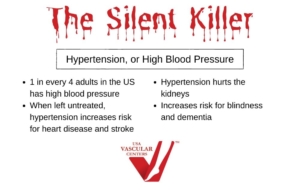What is the “Silent Killer”?
Hypertension, or high blood pressure, is a silent killer because untreated high blood pressure increases risk for various life threatening conditions. Hypertension puts you at risk for heart disease, stroke, kidney damage, dementia, and even blindness.
The Risks
High blood pressure also increases the risk for vascular diseases like Peripheral Artery Disease(PAD). This condition occurs when there is a prolonged increase in blood pressure. This can be from hypertension or an abundance of plaque in the arteries. If blood cannot flow properly through the body, your heart has to work even harder to do its job. According to the National Heart, Lung, and Blood Institute, PAD affects millions of people in the US. PAD often progresses silently due to it’s lack of noticeable symptoms.
Take Action
If you are someone with high blood pressure, or if you think you may have PAD, it’s very important to maintain healthy habits. High blood pressure negatively impacts the body and makes it difficult for certain organs and processes to work properly.
If you have other conditions along with high blood pressure, your risk for heart disease and stroke doubles. If you are diabetic or have high cholesterol, its very important that you avoid anything that is going to negatively harm your body.
Smoking and lack of activity are two main causes of PAD, aside from untreated high blood pressure. If you are over the age of 50 and any of these risk factors apply to you, consult with your doctor immediately. They can help you build a plan that works for your lifestyle to ensure you live a long, healthy life.
Treatment for PAD
At USA Vascular Centers, we specialize in treating Peripheral Artery Disease (PAD). We offer stent angioplasty treatment to improve the blood circulation to your legs and your ability to walk, and lessen the frequency and intensity of pain. Doctors use stent angioplasty to restore the flow of blood to blocked arteries. The non-surgical procedure is fast, virtually painless and minimally invasive–yet highly effective. It involves inserting a tiny tube (catheter) into the affected artery, which implants a small mesh stent that expands by use of a tiny balloon. As the stent expands, it compresses the formation of plaque so that the blood can flow freely through the artery.
Contact Us
If you are at risk for PAD, call 888.773.2193 to schedule a consultation with one our vascular specialists.


